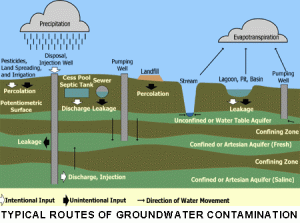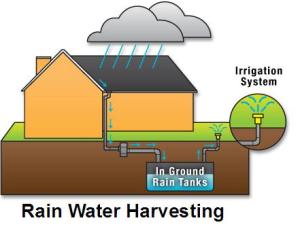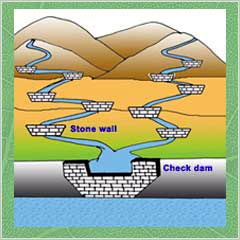A. Introduction - In all its forms, water shapes and nourishes life on Earth. Life on this planet first developed in water, and the world’s unique biodiversity and human communities both depend on clean water’s continued availability. However, less than one percent of the Earth’s fresh water flows freely, and burgeoning human populations are making unsustainable demands on this vital resource. Demand for fresh water is already outstripping supply in many regions around the world. Both biodiversity and human communities are at risk: an estimated one out of every six people on Earth has no access to clean drinking water; two out of six people lack adequate sanitation; and four out of six are afflicted by water-borne illnesses.
Thus, water is a precious resource. Over the years rising populations, growing industrialization, and expanding agriculture have pushed up the demand for water. Efforts have been made to collect water by building dams and reservoirs and digging wells; some countries have also tried to recycle and desalinate (remove salts) water. Water conservation has become the need of the day. The idea of ground water recharging by harvesting rainwater is gaining importance in many cities. In the forests, water seeps gently into the ground as vegetation breaks the fall. This groundwater in turn feeds wells, lakes, and rivers.
B. Water Pollution - Water is one of the prime necessities of life. With increasing number of people depend on this resource; water has become a scarce commodity. Pollution makes even the limited available water unfit for use. Water is said to be polluted when there is any physical, biological or chemical change in water quality that adversely affects living organisms or makes water unsuitable for use. Sources of water pollution are mainly factories, power plants, coal mines and oil wells situated either close to water source or away from sources. They discharge pollutants directly or indirectly into the water sources like river, lakes, water streams etc.

What is Groundwater?
Groundwater is water that has drained through surface layers of soil and rock until it reaches a layer of rock material through which it cannot pass, or can pass only very slowly. This results in the accumulation of water in the rock layers above this impermeable layer. The water is stored in gaps in the rock, or between the particles of which the rock is composed. Rock which retains water in this way is called an aquifer.
Groundwater pollution
An aquifer may be as little as 30m from the surface, or as much as 300m. It costs more to pump water from the deeper aquifer but the water quality in the deeper one may be better than the shallower since contaminants which the water may be carrying are removed as the water moves through the rock.
Historically, groundwater has been naturally very clean because of this filtering effect. However, increased use of chemicals in everyday life means that groundwater is now vulnerable to the same pressures as water at the surface. Since water continuously flows from one to the other, groundwater can become polluted with nutrients or chemicals when surface water carrying these substances drains into the groundwater environment.
Diffuse sources of groundwater contamination include pesticide and fertiliser use. Point-specific sources include industrial spills, leaking oil and chemical storage tanks and landfill sites. Normally it is easier to remedy a point-specific source since its point of origin can be relatively easily identified.
The harmful effects of water pollution are:
(a) human beings become victims of various water borne diseases, such as typhoid, cholera, dysentery, hepatitis, jaundice, etc.
(b) The presence of acids/alkalies in water destroys the microorganisms, thereby hindering the self-purification process in the rivers or water bodies. Agriculture is affected badly due to polluted water. Marine eco-systems are affected adversely.
(c) The sewage waste promotes growth of phytoplankton in water bodies; causing reduction of dissolved oxygen.
(d) Poisonous industrial wastes present in water bodies affect the fish population and deprives us of one of our sources of food. It also kills other animals living in fresh water.
(e) The quality of underground water is also affected due to toxicity and pollutant content of surface water.
Water conservation is a key link between balancing current and future water needs.
C. Water Conservation in Urban Areas – Few tips -
a. Increase the level of organic matter in your soil - Healthy soils should contain at least 5% organic matter (humus). Not only does a high level of organic matter foster
a living and vibrant soil that nurtures your plants, it also absorbs and retains up to 50% more water than soils that are low in organic matter. This means that plants can much more successfully survive during times of drought. Regular addition of locally made compost is the best way to increase the level of organic matter in your soil.
b. Use organic mulches – Soils that are left exposed to the air invite evaporation and dry out quickly. By using organic materials such as leaves, shredded bark, wood chips, newspapers or grass clippings, you are conserving water in the soil. Organic mulches also reduce compaction and are eventually broken down into humus.
c. Reduce lawn area – Most lawns require relatively large amounts of water, not to mention a high degree of maintenance. Consider alternative ground covers, additional shrub beds, organic mulches or “naturalized” plantings of native species as an alternative. Alternative drought tolerant lawn seed mixes are also now available.
d. Chose drought tolerant plant species – Trees, shrubs and perennials differ tremendously in their water needs. By choosing species (often but not always native) that can thrive in dryer environments, you can have a lush yard with little need for supplemental water. Group your plantings together according to their water needs, placing the most drought tolerant species in the driest areas and vice versa.
e. Harvest rooftop rain water – By connecting rain barrels or larger containers to your downspouts, you can hold water until you need it the most. Rain water is much healthier for plants than treated municipal water. Town planners and civic authority in many cities in various countries are introducing bylaws making rainwater harvesting compulsory in all new structures. In India, realizing the importance of recharging groundwater, the CGWB (Central Ground Water Board) is taking steps to encourage it through rainwater harvesting. Some of the benefits of rainwater harvesting are as follows:

* Increases water availability
* Checks the declining water table
* Is environmentally friendly
* Improves the quality of groundwater through the dilution of fluoride, nitrate, and salinity
* Prevents soil erosion and flooding especially in urban areas
f. Grade your landscape to deliver water to where you need it - Most often, our urban yards are graded to move water quickly off our property. By modifying the contours of our landscape, we can direct that water to our trees, shrubs, and gardens while ensuring that it does not enter our basements. Swales (shallow depressions on contour) help to slow down the flow of water and allow it to percolate into the soil.
g. Consider using grey water in the landscape – “Grey water” is household water from sinks, bathtubs and washing machines. Using grey water can be as simple as placing a basin in the sink while washing dishes and using it to water a tree, or it can be more complex and automated (see wwwoasisdesign.net). Grey water use must be approached with caution and may be regulated by local codes or by-laws.
h. Modify your watering habits – If you are using supplemental water in your landscape, watering in the early evening or early morning is most effective and efficient.
Consider using drip-lines and avoid overhead broad casting sprinklers. Watering infrequently but deeply helps plants to establish deep roots that can better withstand drought.
i. Learn How to Conserve Water – Behavioral practices involve changing water use habits so that water is used more efficiently, thus reducing the overall water consumption in a home. These practices require a change in behavior, not modifications in the existing plumbing or fixtures in a home. Behavioral practices for residential water users can be applied both indoors in the kitchen, bathroom, and laundry room and outdoors, all helping to lower utility bills.
D. Water Conservation Methods for industries - Water conservation also needs to be addressed at an industrial level. Some of the ways that can be implemented in industries to conserve water are:
* Conduct regular surveys and examinations to find out the ways for conserving water. Also conduct awareness programs at an employee level.
* Don’t use water where it is unnecessary like, washing driveways, washing trucks frequently, etc. These things can be done with less water or without using any water.
* It is a good idea to install high-pressure but low volume spray nozzles on spray washers.
* Reuse water when it is discharged from various processes.
* Check the efficiency of your water equipment on regular basis.
E. Water Conservation in Agriculture -

Conservation of water in the agricultural sector is essential since water is necessary for the growth of plants and crops. A depleting water-table and a rise in salinity due to overuse of chemical fertilizers and pesticides has made matters serious. Various methods of water harvesting and recharging have been and are being applied all over the world to tackle the problem. In many areas where rainfall is low and water is scarce, the local people have used simple techniques that are suited to their region and reduce the demand for water. These include construction of ‘tanks’ or dams etc., by bunding or by excavating the ground and collecting rainwater. At the end of the monsoon season, water from these structures was used to cultivate crops.
F. Improving efficiency of water used for agriculture – Simple techniques can be used to reduce the demand for water. The underlying principle is that only part of the rainfall or irrigation water is taken up by plants, the rest percolates into the deep groundwater, or is lost by evaporation from the surface. Therefore, by improving the efficiency of water use, and by reducing its loss due to evaporation, we can reduce water demand. There are numerous methods to reduce such losses and to improve soil moisture. Some of them are listed below.
* Mulching, i.e., the application of organic or inorganic material such as plant debris, compost, etc., slows down the surface run-off, improves the soil moisture, reduces evaporation losses and improves soil fertility.
* Soil covered by crops, slows down run-off and minimizes evaporation losses. Hence, fields should not be left bare for long periods of time.
* Ploughing helps to move the soil around. As a consequence it retains more water thereby reducing evaporation.
* Shelter belts of trees and bushes along the edge of agricultural fields slow down the wind speed and reduce evaporation and erosion.
* Planting of trees, grass, and bushes breaks the force of rain and helps rainwater penetrate the soil.
* Fog and dew contain substantial amounts of water that can be used directly by adapted plant species. Artificial surfaces such as netting-surfaced traps or polyethylene sheets can be exposed to fog and dew. The resulting water can be used for crops.
* Contour farming is adopted in hilly areas and in lowland areas for paddy fields. Farmers recognize the efficiency of contour-based systems for conserving soil and water.
* Salt-resistant varieties of crops have also been developed recently. Because these grow in saline areas, overall agricultural productivity is increased without making additional demands on freshwater sources. Thus, this is a good water conservation strategy.
* Transfer of water from surplus areas to deficit areas by inter-linking water systems through canals, etc.
* Desalination technologies such as distillation, electro-dialysis and reverse osmosis are available.
* Use of efficient watering systems such as drip irrigation and sprinklers will reduce the water consumption by plants.
G. Federal / State Government’s legislations towards water conservation - In the past, water supply utilities typically met growing demand for water consumption by expanded supply infrastructures. Normally this was subsidised from the public purse. Environmental costs were rarely considered. An ever-expanding water supply has, however, become too expensive. New water supply systems face a shortage of suitable sites and escalating financial and environmental costs.
Growing population, water shortages, climate change, and the need to protect every country’s / state’s fish and wildlife make it imperative that the various Governments manage its water resources as efficiently as possible. Improvements in technology and management practices offer the potential for increasing water conservation in country over time, enabling them to meet its water supply needs for urban, agricultural, and environmental water uses. In addition to helping existing water supplies go further, any Government’s investments in water conservation also help to:
* Reduce dependence on water diversions from severely stressed ecosystems;
* Reduce dependence on imported water supplies that are at vulnerable to seismic events, flooding and climate change;
* Reduce energy use associated with water delivery, treatment and use;
* Reduce greenhouse gas emissions, helping to reach California’s climate change and greenhouse gas emissions reduction goals;
* Increase local water self-reliance; and
* Improve water quality by reducing polluted urban and agricultural runoff.
Thus, the legislations prepared by nation’s Federal / State Governments to ensure that it manages its water resources as efficiently as possible, thereby stretching state and local water and energy supplies, reducing energy use and greenhouse gas emissions, reducing costs, and protecting their Bay/Delta and other aquatic ecosystems.
H. Conclusion - Freshwater ecosystems are under siege in many parts of the world — and one often overlooked driver of this crisis is ‘How we value and price water’. Water doesn’t cost the same everywhere. In fact, the price of water varies widely between countries, between cities and rural areas, and even between economic sectors such as irrigation agriculture (whose water use is generally subsidized) or industry. Regardless of who you are, however, the price you pay for water is but a small fraction of what it actually costs to extract water, deliver it to users, and treat it after its use.
Other hidden costs of using water, such as the ecological degradation of rivers and lakes that results from taking too much of their water, or the time women and girls in developing countries spend fetching water from common wells instead of attending school — have been universally ignored.
These ecological impacts can be devastating to local communities that depend upon fish and other benefits of healthy freshwater ecosystems for their livelihoods and well-being.
As the global population has grown and industrialized, we have tapped (and in many cases, polluted) most of the easily-accessible sources of fresh water. As water scarcity increases, so does the cost of supplying it from remote sources.
These increasing costs have slowly provided incentives to change the way we value water. The next big idea in freshwater conservation is to treat water as an economic goods and price it accordingly to reflect its true cost.
In fact, there has been a long debate in environmental economics over the role of prices versus the role of regulatory controls (allocation by governments) in reducing consumption and pollution. Economists stress the efficiency of pricing and environmentalists empahsise the effectiveness of regulations. Equity issues receive little attention from either.
[For more refer ' Sewage Treatment and Recycling of Waste Water ' ]
References:
1. http://edugreen.teri.res.in/explore/water/conser.htm
2. http://www.cleanwateraction.org/programinitiative/water-conservation
3. http://www.nature.org/tncscience/bigideas/people/art23907.html
4. http://www.waterbydesign.com.au/whatisWSUD
5. http://www.ericwjones.com/rain_water.htm
6. http://www.scwa.ca.gov/water_conservation/
7. http://www.waterconserve.org/
No comments:
Post a Comment